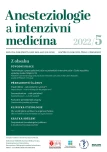Suxamethonium – is it still needed?
Authors:
K. Cvachovec
Authors‘ workplace:
Katedra anesteziologie a intenzivní medicíny IPVZ Praha
; Fakulta zdravotnických studií TU v Liberci
; Klinika anesteziologie, resuscitace a intenzívní medicíny 2. LF UK Praha ve FN Motol, Praha
Published in:
Anest. intenziv. Med., 33, 2022, č. 5, s. 213-216
Category:
Review Article
doi:
https://doi.org/10.36290/aim.2022.042
Overview
After decades of use, the consumption of suxamethonium is decreasing. Anesthetists – and not only they – became accustomed to its use. They respect its contraindications, not unimportant side effects, and use it when perceived benefit prevails over possible risks. Available data show that suxamethonium is still used, although the scope of its indications has diminished. Its use is appropriate during crash induction to anesthesia or whenever the need to secure the airways quickly arises, in ENT and dental or maxillofacial surgery, during electroshock therapy, and in managing certain complications of anesthesia. Like with the use of all neuromuscular blocking agents the recovery from its effect should be objectively assessed. It is the key to the safety of its use. Objections that it is unfeasible in depolarizing blocks can not succeed. Appropriate methods are available and needed technical support is commercially available.
Keywords:
tracheal intubation – suxamethonium – depolarizing neuromuscular block – rapid‑sequence induction
Sources
1. Wylie WD, Churchill‑Davidson HC. A Practice of Anaesthesia. 3.rd ed. Londýn: Lloyd‑Luke (Medical Books) Ltd., 1972, p. 1549. ISBN 0 85324 094 9.
2. Blobner M, Hunter JM. Another nail in the coffin of succinylcholine? Br J Anaesth. 2020 Oct;125(4):423-425. doi: 10.1016/j.bja.2020. 06. 025. Epub 2020 Jul 15. PMID: 32682561.
3. Lee C. Goodbye suxamethonium! Anaesthesia. 2009 Mar;64 Suppl 1 : 73-81. doi: 10.1111/j. 1365-2044.2008.05873.x. PMID: 19222434.
4. WHO model list of essential medicines – 22nd list. 2021. Available from: https://www. who.int/publications/i/item/WHO‑MHP‑HPS‑EML - 2021. 01.
5. Putzu A, Tramèr MR, Giffa M, Czarnetzki C. The optimal dose of succinylcholine for rapid sequence induction: a systematic review and meta‑analysis of randomized trials. BMC Anesthesiol. 2020 Mar 2;20(1):54. doi: 10.1186/s12871-020-00968-1. PMID: 32122305; PMCID: PMC7053066.
6. Tran DT, Newton EK, Mount VA, Lee JS, Wells GA, Perry JJ. Rocuronium versus succinylcholine for rapid sequence induction intubation. Cochrane Database Syst Rev. 2015 Oct 29;2015(10):CD002788. doi: 10.1002/14651858.CD002788.pub3. PMID: 26512948; PMCID: PMC7104695.
7. de Carvalho CC, da Silva DM, de Athayde Regueira SLP, de Souza ABS, Rego CO, Ramos IB, et al. Comparison between rocuronium and succinylcholine for rapid sequence induction: A systematic review and network meta‑analysis of randomized clinical trials. J Clin Anesth. 2021 Sep;72 : 110265. doi: 10.1016/j.jclinane.2021.110265. Epub 2021 Apr 2. PMID: 33819827.
8. Klucka J, Kosinova M, Zacharowski K, De Hert S, Kratochvil M, Toukalkova M, et al. Rapid sequence induction: An international survey. Eur J Anaesthesiol. 2020 Jun;37(6):435-442. doi: 10.1097/EJA.0000000000001194. PMID: 32221099; PMCID: PMC7259384.
9. Odor PM, Bampoe S, Moonesinghe SR, Andrade J, Pandit JJ, Lucas DN; Pan‑London Perioperative Audit and Research Network (PLAN), for the DREAMY Investigators Group. General anaesthetic and airway management practice for obstetric surgery in England: a prospective, multicentre observational study. Anaesthesia. 2021 Apr;76(4):460-471. doi: 10.1111/anae.15250. Epub 2020 Sep 21. PMID: 32959372.
10. Thomsen JLD, Staehr‑Rye AK, Mathiesen O, Hägi‑Pedersen D, Gätke MR. A retrospective observational study of neuromuscular monitoring practice in 30,430 cases from six Danish hospitals. Anaesthesia. 2020 Sep;75(9):1164-1172. doi: 10.1111/anae.15083. Epub 2020 May 15. PMID: 32412659; PMCID: PMC7496504.
11. Wilson JW, Gillen JP, Maute T. Patient Safety during Rapid Sequence Intubation When Using Succinylcholine Instead of Nondepolarizing Paralytic Agents: Should We Change a Common Rapid Sequence Intubation Pathway? J Emerg Trauma Shock. 2020 Oct‑Dec; 13(4):264-268. doi: 10.4103/JETS.JETS_92_18. Epub 2020 Dec 7. PMID: 33897142; PMCID: PMC8047958.
12. West JR, O’Keefe BP, Russell JT. Predictors of first pass success without hypoxemia in trauma patients requiring emergent rapid sequence intubation. Trauma Surg Acute Care Open. 2021 Jun 30;6(1):e000588. doi: 10.1136/tsaco-2020-000588. PMID: 34263062; PMCID: PMC8246356.
13. Guihard B, Chollet‑Xémard C, Lakhnati P, Vivien B, Broche C, Savary D, et al. Effect of Rocuronium vs Succinylcholine on Endotracheal Intubation Success Rate Among Patients Undergoing Out‑of‑Hospital Rapid Sequence Intubation: A Randomized Clinical Trial. JAMA. 2019 Dec 17;322(23):2303-2312. doi: 10.1001/jama.2019.18254. PMID: 31846014; PMCID: PMC6990819.
14. Gil‑Jardiné C, Jabre P, Adnet F, Nicol T, Ecollan P, Guihard B, et al. Incidence and factors associated with out ‑ of‑hospital peri ‑ intubation cardiac arrest: a secondary analysis of the CURASMUR trial. Intern Emerg Med. 2022 Mar;17(2):611-617. doi: 10.1007/s11739-021 - 02903-9. Epub 2022 Jan 17. Erratum in: Intern Emerg Med. 2022 Feb 12: PMID: 35037125.
15. Bash LD, Black W, Turzhitsky V, Urman RD. Neuromuscular Blockade and Reversal Practice Variability in the Outpatient Setting: Insights From US Utilization Patterns. Anesth Analg. 2021 Dec 1;133(6):1437-1450. doi: 10.1213/ANE.0000000000005657. PMID: 34784330.
16. Schaefer MS, Hammer M, Santer P, Grabitz SD, Patrocinio M, Althoff FC, et al. Succinylcholine and postoperative pulmonary complications: a retrospective cohort study using registry data from two hospital networks. Br J Anaesth. 2020 Oct;125(4):629-636. doi: 10.1016/j.bja.2020. 05. 059. Epub 2020 Jul 10. PMID: 32654742.
17. Kopman AF, Brull SJ. Not another requiem for succinylcholine. Comment on Br J Anaesth 2020; 125 : 423-5. Br J Anaesth. 2020 Oct;125(4):e349-e350. doi: 10.1016/j.bja.2020. 07. 007. Epub 2020 Aug 1. PMID: 32747076.
18. Schmartz D, Chénard L, Baumann C, Fuchs‑Buder T. A modified train‑of‑four ratio to assess recovery from depolarizing neuromuscular blockade after succinylcholine, a prospective observational study. J Clin Monit Comput. 2021 Oct;35(5):1133-1138. doi: 10.1007/ s10877-020-00560-5. Epub 2020 Jul 20. PMID: 32691282.
Labels
Anaesthesiology, Resuscitation and Inten Intensive Care MedicineArticle was published in
Anaesthesiology and Intensive Care Medicine

2022 Issue 5
Most read in this issue
- Suxamethonium – is it still needed?
- Vliv umělé plicní ventilace na orgánové funkce
- Impact factor – how to distinguish the proper one?
- PR illiteracy of anaesthesiologists?
